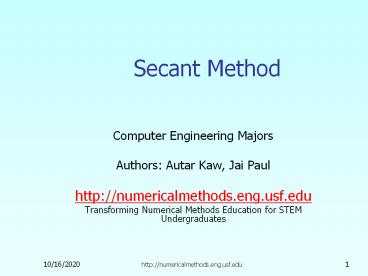Secant Method - PowerPoint PPT Presentation
Title:
Secant Method
Description:
A power point presentation to show how the Secant method of finding roots of a nonlinear equation works. – PowerPoint PPT presentation
Number of Views:408
Avg rating:3.0/5.0
Title: Secant Method
1
Secant Method
- Computer Engineering Majors
- Authors Autar Kaw, Jai Paul
- http//numericalmethods.eng.usf.edu
- Transforming Numerical Methods Education for STEM
Undergraduates
2
Secant Method http//numericalmethods.eng.u
sf.edu
3
Secant Method Derivation
Newtons Method
(1)
Approximate the derivative
(2)
Substituting Equation (2) into Equation (1) gives
the Secant method
Figure 1 Geometrical illustration of the
Newton-Raphson method.
4
Secant Method Derivation
The secant method can also be derived from
geometry
The Geometric Similar Triangles
can be written as
On rearranging, the secant method is given as
Figure 2 Geometrical representation of the
Secant method.
5
Algorithm for Secant Method
6
Step 1
Calculate the next estimate of the root from two
initial guesses
Find the absolute relative approximate error
7
Step 2
- Find if the absolute relative approximate error
is greater than the prespecified relative error
tolerance. - If so, go back to step 1, else stop the
algorithm. - Also check if the number of iterations has
exceeded the maximum number of iterations.
8
Example 1
- To find the inverse of a number a, one can use
the equation
where x is the inverse of a.
- Use the Secant method of finding roots of
equations to - Find the inverse of a 2.5. Conduct three
iterations to estimate the root of the above
equation. - Find the absolute relative approximate error at
the end of each iteration, and - The number of significant digits at least correct
at the end of each iteration.
9
Example 1 Cont.
Solution
Figure 3 Graph of the function f(x).
10
Example 1 Cont.
Initial guesses
Iteration 1 The estimate of the root is
The absolute relative approximate error is
The number of significant digits at least correct
is 0.
Figure 4 Graph of the estimated root after
Iteration 1.
11
Example 1 Cont.
Iteration 2 The estimate of the root is
The absolute relative approximate error is
The number of significant digits at least correct
is 0.
Figure 5 Graph of the estimated root after
Iteration 2.
12
Example 1 Cont.
Iteration 3 The estimate of the root is
The absolute relative approximate error is
The number of significant digits at least correct
is 0.
Figure 6 Graph of the estimated root after
Iteration 3.
13
Advantages
- Converges fast, if it converges
- Requires two guesses that do not need to bracket
the root
14
Drawbacks
Division by zero
15
Drawbacks (continued)
Root Jumping
16
Additional Resources
- For all resources on this topic such as digital
audiovisual lectures, primers, textbook chapters,
multiple-choice tests, worksheets in MATLAB,
MATHEMATICA, MathCad and MAPLE, blogs, related
physical problems, please visit - http//numericalmethods.eng.usf.edu/topics/secant_
method.html
17
- THE END
- http//numericalmethods.eng.usf.edu































